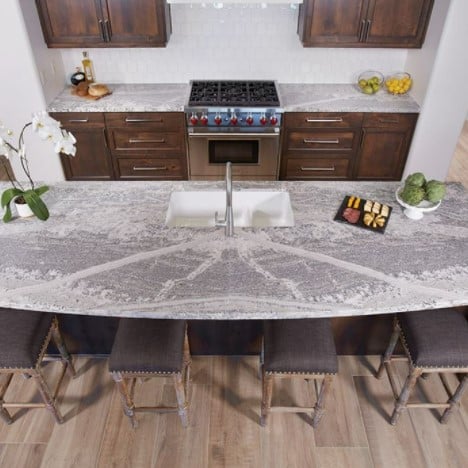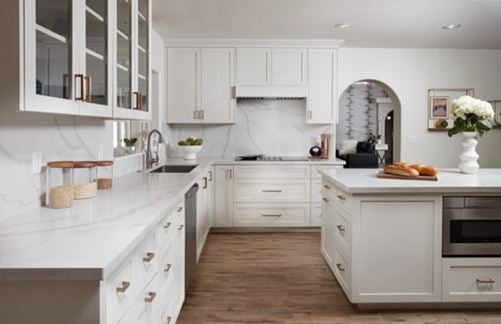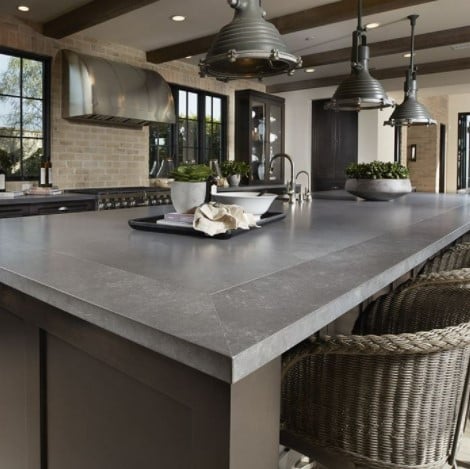
A gorgeous stone or quartz countertop can drastically elevate your kitchen or bathroom design. Countertops should be eye-catching in a good way, instead of standing out because of glaring seams. Fortunately, there are ways to make your countertop seams as hidden as possible. By understanding how to minimize the appearance of seams, you can get the countertop of your dreams, without the seams.
What Are Countertop Seams
Countertop seams occur when two separate segments are joined together to form the larger countertop. For many kitchen countertop sizes and layouts, seams are usually unavoidable.
Slab countertops, like granite or quartz, are beautiful, luxurious, and practical. Slab countertops also have size restraints for each piece because they have to be manageable and safe to transport into your home or business.
Even though seams are often unavoidable, your design and installation team will work hard to make the seams as inconspicuous as possible.
Why People Choose to Hide Countertop Seams
Like many design choices, hiding countertop seams is mostly for aesthetic reasons. When you step into your dream kitchen, a bad countertop seam shouldn’t be the first thing you see. You should be able to enjoy the stunning countertop surface, like the unique blue-gray crystal patterns in the Blue Galaxy granite countertops, instead of first noticing unpleasant seams. Carefully camouflaging countertop seams will help you forget they are even there.
Although aesthetics are the main reason for hiding countertop seams, there is a potentially higher risk of mold or grimy build-up if countertops are installed improperly. Bad seams may indicate an overall unprofessional installation, so make sure your installation team knows where to put the seams and how to camouflage them properly. Don’t be afraid to ask questions to ensure that proper installation with hidden seams is their priority.

How to Hide a Countertop Seam
The best way to hide countertop seams is to have them installed by experienced professionals. Your countertop fabricators will take these factors into account when hiding countertop seams:
Countertop Seam Location
To meet industry standards, a seam should be 1/16th of an inch wide or less. Although this is not very big, the location of these seams matters. You may be able to hide seams in a less conspicuous spot like in a corner or under cabinets. Your designers will work with you to find a spot for the seams that will allow structural integrity of the countertops and limit seam visibility as much as possible.
Countertop Seam Color
Seams are sealed with an epoxy resin. To disguise the seam, your installation team will create a colored epoxy that matches the main tone of the countertops. They will take this color-matched epoxy and create a flat and even seam.
Countertop Lippage
If the countertop segments aren’t installed properly on an even level, then the seam will be much more noticeable. Your installation team may even out the cabinet base or the countertop height in order to have equal countertop pieces with a flat surface to rest on. Keep in mind that your fabricators may go through many rounds of leveling and placement before it reaches the final result.
Color and Pattern of Countertop Segments
Even the tightest seam can become incredibly noticeable if the two conjoined countertop segments don’t look alike. When designing your dream countertop, you can work with your granite or quartz fabricators to ensure that the different segments still have a similar pattern and tone.

Granite Countertops
Granite countertops are a popular countertop option because their one-of-a-kind natural stone patterns are eye-catching in the best way. Imagine the unique veining and patterns of natural stone, like the gorgeous Monte Cristo granite with its subtle yellow and blue tones, as the dramatic centerpiece of your kitchen.
When filling seams in granite countertops, your installation team will choose an epoxy color that matches the overall tone of your granite selection. Before installation, you and your designers will create a layout that showcases the granite’s most beautiful sections while also determining where to put seams to minimize how much they stand out. Your granite slabs should come from the same section of stone so that variation in color and pattern is minimized. The granite will also have to be cut with an even edge in order for the seam to be easy to disguise.

Quartz Countertops
Quartz is another great option for your countertops. This manufactured stone is visually appealing and durable like granite but because of its non-porous material, it’s even less maintenance. You can elevate your kitchen’s design and functionality with a stunning slab of Metropolis Grey quartz. Unfortunately, matching quartz patterns at the seams can be challenging as many quartz slabs are book matched, which is a technique used by fabricators to plan cuts so that the pattern has the illusion of continuing from one slab to another. Many quartz products only have one pattern, eliminating the option of mirroring the pattern to reduce viability.
Your fabricators will disguise quartz countertop seams by matching the epoxy color to the countertop color. For example, the dramatic yet incredibly versatile Bertoli Quartz countertop in rich white will have camouflaged seams with white epoxy. Since this countertop is a uniform color, using a white epoxy will diminish the visibility of a seam between the two countertop segments.
Get Started on Your Countertop Remodel
A beautiful stone or quartz countertop is the perfect feature to instantly improve your kitchen or bathroom design. At Arizona Tile, you can explore our collection of granite and quartz countertops that are as luxurious as they are practical. To elevate your design even further, consider pairing a stone countertop with a textured tile backsplash. Check out our design tools to experiment with different countertop and tile options or contact us to get started with your dream remodel.





